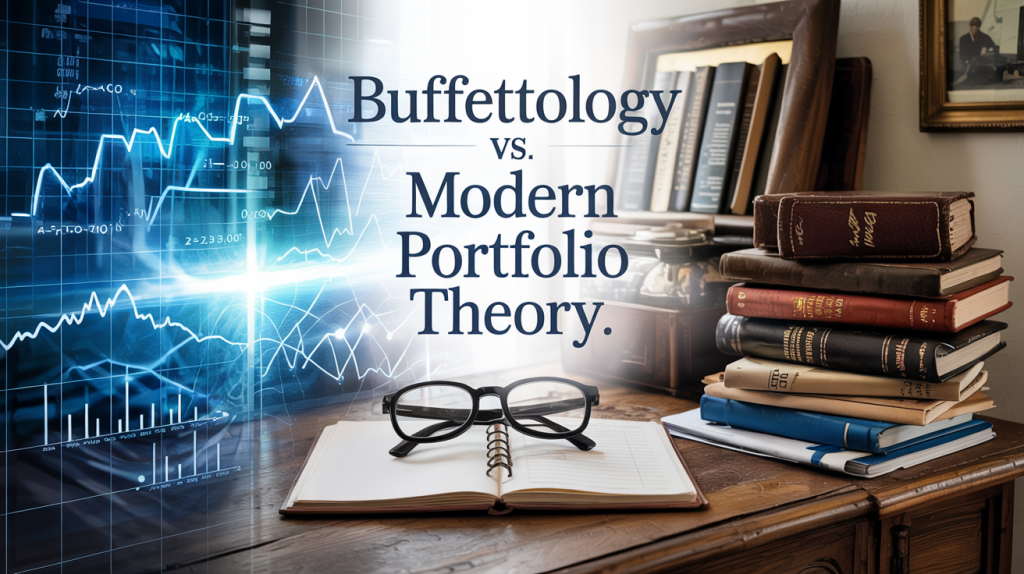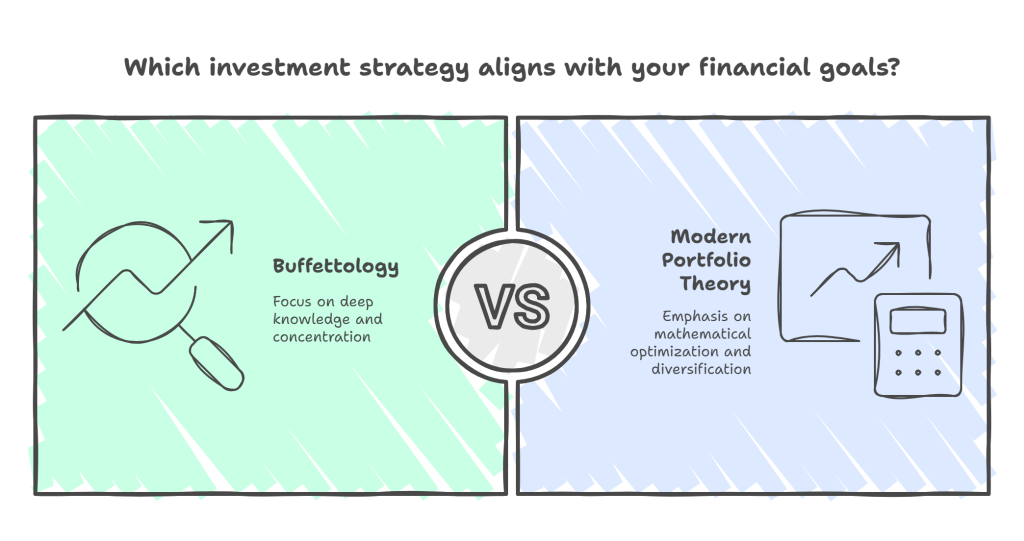
What if everything you’ve been taught about risk is wrong?
Wall Street says volatility is your enemy. Buffett says it’s your friend. Financial advisors beg you to diversify. Buffett made billions by betting on just a few ideas. One side crunches equations. The other reads annual reports. And yet both claim to hold the key to lasting wealth.
This isn’t just a debate about strategy. It’s a philosophical split that will shape how you invest, how you sleep at night, and whether you build real wealth—or just chase safety. And at the center of this debate sits Modern Portfolio Theory, the dominant framework that has shaped how most financial advisors, institutions, and textbooks define risk and design portfolios. But is it the right framework for you?
So who’s right? And more importantly, where do you stand?
Diversify Everything or Bet Big? The Choice That Shapes Your Financial Future
One preaches wide diversification, the other tells you to concentrate on your best ideas. Modern Portfolio Theory (MPT) says the rational investor builds a mathematically optimized basket of uncorrelated assets to manage risk. Warren Buffett says risk is not volatility, but the chance you permanently lose money—and the best way to manage it is to know exactly what you own.
You can’t follow both approaches. So which one fits your investing DNA?
What Is Risk, Really? Volatility vs. Permanent Capital Loss
Modern Portfolio Theory defines risk as volatility—how much your portfolio bounces up and down. This statistical view assumes price movement equals uncertainty. A portfolio that moves less is considered safer. That’s why MPT favors combining asset classes that don’t move in sync: smooth out the ride, and you supposedly reduce the risk.
Buffett disagrees. He defines risk as the chance of losing money and not getting it back. To him, the real danger is not temporary declines but overpaying for something that turns out to be worth far less. A stock that drops 30% is not risky if the intrinsic value remains intact. In fact, it’s an opportunity.
This clash in definitions drives every other decision. If you think risk is volatility, you want smooth returns. If you think risk is permanent loss, you want to avoid overpaying. The way you define risk determines your investing strategy.
Real-World Diversification vs. Buffett’s Focused Bets
Modern Portfolio Theory encourages owning hundreds of securities across industries, sectors, and geographies. The idea is simple: the more you diversify, the more you reduce volatility. The math holds up. But the real world isn’t a spreadsheet.
Private investors don’t have infinite capital or time. Excessive diversification becomes “deworsification”—owning so many positions that none of them matter. It creates a false sense of safety while diluting your best ideas.
Buffett runs a concentrated portfolio. He’s held outsized positions in Coca-Cola, American Express, and Apple for years. Why? Because when you find a wonderful business at a fair price, you bet big. “Diversification is protection against ignorance,” he says. “If you know what you are doing, it makes very little sense.”
The question for you: do you know what you’re doing? If you do, maybe you don’t need to own 100 stocks.
The Data Game: MPT’s Models vs. Buffett’s Business Thinking
Modern Portfolio Theory leans heavily on historical data. Expected returns, standard deviation, correlation coefficients—all neatly modeled and optimized. It’s elegant and mathematical, and it assumes the market is efficient.
Buffett ignores most of that. He focuses on understanding the business. What are its competitive advantages? Is management trustworthy? How resilient are the cash flows? He treats stock ownership as business ownership, not as a statistical exercise.
MPT treats stocks as data points. Buffett treats them as living, breathing enterprises. This difference changes everything about how you allocate capital.
If you’re using spreadsheets to avoid thinking, you may be doing it wrong. Are you modeling the past or understanding the future?

Finding Your Place on the Spectrum: Integrating Buffett’s Wisdom with Mathematical Precision
You don’t have to live at either extreme. Most private investors do best somewhere in the middle. A portfolio of 10 to 20 well-researched holdings can offer enough diversification to manage risk while still allowing you to understand what you own.
If you’re confident in your valuation process and can calculate a margin of safety, leaning toward Buffettology makes sense. If you lack the time or temperament to dive deep into businesses, a passive Modern Portfolio Theory-based strategy might be safer and less stressful.
The key is self-awareness. Know what kind of investor you are. You can absolutely follow Buffett’s principles—deep conviction, margin of safety, concentration—and still optimize your portfolio mathematically using tools like the Kelly Criterion. This approach combines the wisdom of Buffettology with the precision of modern portfolio theory, allocating capital based on expected returns, volatility, and correlation. It’s not either/or. It’s how you integrate the best of both worlds into a system that works for you. Be honest about your skills, your temperament, and your time horizon. The market rewards consistency far more than cleverness.
Two Roads to Wealth—Which One Will You Walk?
Modern Portfolio Theory builds portfolios like engineers build bridges—optimized, stress-tested, and statistically sound. Buffettology builds portfolios like a craftsman builds furniture—slowly, carefully, with deep knowledge of every grain.
Both approaches can make you wealthy. But only one will feel natural to you. And the one that feels natural is the one you’ll stick with when the market gets rough.
That’s the only strategy that matters.

Shailesh Kumar, MBA is the founder of Astute Investor’s Calculus, where he shares high-conviction small-cap value ideas, stock reports, and investing strategies.
His work has been featured in the New York Times and profiled on Wikipedia. He previously ran Value Stock Guide, one of the earliest value investing platforms online.
Subscribe to the Inner Circle to access premium stock reports and strategy insights.
Featured in:








